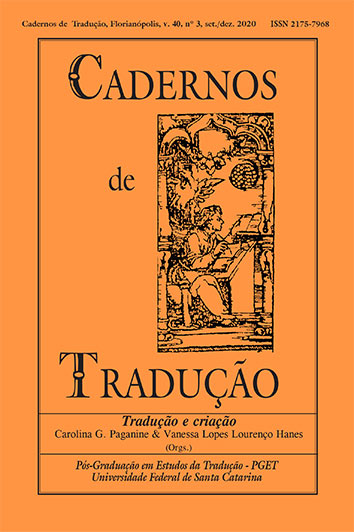“Dança de força”: elementos estruturais em três traduções de Rainer Maria Rilke
DOI:
https://doi.org/10.5007/2175-7968.2020v40n3p109Resumo
No presente artigo, pretendo investigar se e em que medida os elementos estruturais do poema “Der Panther” (“A pantera”) de Rainer Maria Rilke foram recriados por três de seus mais reconhecidos tradutores brasileiros, a saber: por Geir Campos (1924-1999) em 1953, por José Paulo Paes (1926-1998) em 1993 e por Augusto de Campos (1931- ) em 1994. Partindo do pressuposto apresentado por Haroldo de Campos no ensaio “Da tradução como criação e como crítica” (1963), segundo o qual a tradução de poesia seria um trabalho com o “próprio signo, ou seja, sua fisicalidade, sua materialidade mesma” (Campos 34), pretendo apontar primeiramente a importância ainda maior de tais elementos naqueles poemas rilkeanos que, como “Der Panther”, vêm sendo há quase 100 anos descritos pela crítica (Müller 298) como “Dinggedicht” (ou “poema-coisa”); realizando, em seguida, uma breve análise dos elementos estruturais do poema original (aqui entendidos como metro, aliterações, assonâncias, movimento frasal e outros aspectos da materialidade do signo linguístico); para chegar, finalmente, a uma breve leitura comparada das maneiras como os três tradutores lidaram com esses elementos estruturais em suas respectivas traduções para o português.Referências
Back, Manfred. “Das Anschauen ist eine so wunderbare Sache...‘.Rilkes, Panther’ nach dem Sprung ins Dinggedicht”. Kleine Lauben, Arcadien und Schnabelewopski. Festschrift für Klaus Jeziorkowski, Ingo Wintermeyer (org.). Würzburg: Königshausen und Neumann, 1995, pp. 123–131.
Campos, Haroldo de (a). “Translation as Creation and Criticism.”. Novas: Selected Writings, A. S. Bessa e O. Cisneros (org.). Tradução de Diana Gibson e Haroldo de Campos. Evanston: Northwestern University Press, 2007, pp. 312-326.
Campos, Haroldo de (b). Da Transcriação: poética e semiótica da operação tradutora. Belo Horizonte: FALE-UFMG, 2011.
Engel, Manfred. “Rilke als Autor der literarischen Moderne”, Rilke-Handbuch:Leben – Werk – Wirkung, Manfred Engel (org.). Stuttgart: J.B. Metzler, 2013, pp. 521-524.
Koller, Werner. Einführung in die Übersetzungswissenschaft. 8ª edição. Tübingen: Narr Francke Attempto, 2011.
Kramer, Andreas. “Rilke and modernism”. The Cambridge Companion to Rilke, Karen Leeder e Robert Vilain (org.). Cambridge: Cambridge University Press, 2010, pp. 113-130.
Kügler, Hans. “Rainer Maria Rilke. Der Panther”. Gedichte aus sieben Jahrhunderten – Interpretationen, Karl Hotz (org.). Bamberg: Buchner, 1987, p. 211.
Leeder, Karen. “Rilke’s legacy in the English-speaking world”. The Cambridge Companion to Rilke, Karen Leeder e Robert Vilain (org.). Cambridge: Cambridge University Press, 2010, pp. 189-205.
Levý, Jiří. “Übersetzen als Entscheidungsprozess”. Übersetzungswissenschaft, Wilss, Wolfram (org.). Darmstadt: Ernst Klett Verlag, 1981, pp. 219-235.
Louth, Charlie. “Early poems”. The Cambridge Companion to Rilke, Karen Leeder e Robert Vilain (org.). Cambridge: Cambridge University Press, 2010, pp. 41-58.
Müller, Wolfgang. “Neue Gedichte / Der Neuen Gedichte anderer Teil”. Rilke-Handbuch: Leben – Werk – Wirkung, Manfred Engel (org.). Stuttgart: J.B. Metzler, 2013, pp. 296-317.
Oppert, Kurt. “Das Dinggedicht. Eine Kunstform bei Morike, Meyer und Rilke”. DVjs 4 (1926): 747–783.
Rilke, Rainer Maria (a). Briefe aus den Jahren 1906 bis 1907 Ruth Sieber-Rilke e Carl Sieber (org.). Leipzig: Insel Verlag, 1930.
Rilke, Rainer Maria (b). Neue Gedichte und Der neuen Gedichte anderer Teil. Frankfurt am Main: Insel Verlag, 1975.
Rilke, Rainer Maria (c). Briefe über Cézanne. (organização de Clara Rilke). Frankfurt am Main: Insel Verlag, 1983.
Rilke, Rainer Maria (d). Poemas. Tradução de José Paulo Paes. São Paulo: Companhia das Letras, 2012.
Rilke, Rainer Maria (e). Coisas e anjos de Rilke. Tradução de Augusto de Campos. São Paulo: Perspectiva, 2013.
Rilke, Rainer Maria (f). Poemas e Cartas a um Jovem Poeta. Tradução, seleção e notas de Geir Campos e Fernando Jorge. Rio de Janeiro: Nova Fronteira, 2017.
Tápia, Marcelo. “Haroldo de Campos: a tradução como prática isomórfica”. Revista Olhar. Nº 16 (2007): 9-16. CECH/UFSCar. 09/10/2019. Disponível em: https://issuu.com/revistaolhar/docs/olhar_16/9.
Unglaub, Erich. Panther und Aschanti. Rilke-Gedichte in kulturwissenschaftlicher Sicht. Frankfurt am Main: Lang, 2005.
Downloads
Publicado
Como Citar
Edição
Seção
Licença
Autores têm autorização para assumir contratos adicionais separadamente, para distribuição não exclusiva da versão do trabalho publicada nesta revista (ex.: publicar em repositório institucional ou como capítulo de livro, com reconhecimento de autoria e publicação inicial nesta revista).





















































